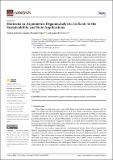Por favor, use este identificador para citar o enlazar a este item:
http://hdl.handle.net/10261/271804COMPARTIR / EXPORTAR:
 SHARE SHARE
 CORE
BASE CORE
BASE
|
|
| Visualizar otros formatos: MARC | Dublin Core | RDF | ORE | MODS | METS | DIDL | DATACITE | |

| Título: | Horizons in asymmetric organocatalysis: En Route to the sustainability and new applications |
Autor: | Ardevines, Sandra CSIC ORCID; Marqués-López, Eugenia CSIC ORCID; Herrera, Raquel P. CSIC ORCID | Palabras clave: | Chirality Sustainability Enantioselective Organocatalysis Green chemistry |
Fecha de publicación: | 2022 | Editor: | Multidisciplinary Digital Publishing Institute | Citación: | Catalysts 12(1): 101 (2022) | Resumen: | Nowadays, the development of new enantioselective processes is highly relevant in chemistry due to the relevance of chiral compounds in biomedicine (mainly drugs) and in other fields, such as agrochemistry, animal feed, and flavorings. Among them, organocatalytic methods have become an efficient and sustainable alternative since List and MacMillan pioneering contributions were published in 2000. These works established the term asymmetric organocatalysis to label this area of research, which has grown exponentially over the last two decades. Since then, the scientific community has attended to the discovery of a plethora of organic reactions and transformations carried out with excellent results in terms of both reactivity and enantioselectivity. Looking back to earlier times, we can find in the literature a few examples where small organic molecules and some natural products could act as effective catalysts. However, with the birth of this type of catalysis, new chemical architectures based on amines, thioureas, squaramides, cinchona alkaloids, quaternary ammonium salts, carbenes, guanidines and phosphoric acids, among many others, have been developed. These organocatalysts have provided a broad range of activation modes that allow privileged interactions between catalysts and substrates for the preparation of compounds with high added value in an enantioselective way. Here, we briefly cover the history of this chemistry, from our point of view, including our beginnings, how the field has evolved during these years of research, and the road ahead. | Versión del editor: | https://doi.org/10.3390/catal12010101 | URI: | http://hdl.handle.net/10261/271804 | DOI: | 10.3390/catal12010101 | E-ISSN: | 2073-4344 |
| Aparece en las colecciones: | (ISQCH) Artículos |
Ficheros en este ítem:
| Fichero | Descripción | Tamaño | Formato | |
|---|---|---|---|---|
| horizonappli.pdf | 3,78 MB | Adobe PDF |  Visualizar/Abrir |
CORE Recommender
SCOPUSTM
Citations
12
checked on 24-abr-2024
WEB OF SCIENCETM
Citations
8
checked on 29-feb-2024
Page view(s)
38
checked on 30-abr-2024
Download(s)
34
checked on 30-abr-2024
Google ScholarTM
Check
Altmetric
Altmetric
Este item está licenciado bajo una Licencia Creative Commons

